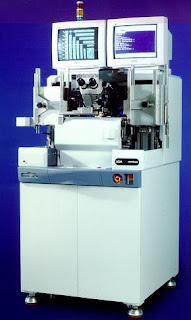document.write(get_publication('Semiconductor International'));
Semiconductor International, 11/1/2006
Many methods for stacking die have been employed in the name of miniaturization, especially for mobile applications. Stacked package arrangements give the advantage of assembling die that have been tested and burned in as packaged devices. Tessera (San Jose) has been developing a new contact for its stackable package to reduce its height. Some of the details of this microcontact array technology were revealed in a paper presented at this year's SMTA International Conference
The micro contacts themselves are <150 µm high and have a conical profile. They are ~100 µm wide at the base and 80 µm at the tip, with a slightly narrower neck. The small diameter makes it possible to pack more contacts into the same area. Another advantage being emphasized is the ability to route more wires between two contacts for a given pitch. In addition to using them for memory stacks (Fig 1), the company has explored their use with system-in-a-package (SiP) applications.

Two keys for this contact to be practical are high coplanarity and the conical shape. Both of these are achieved by etching the contacts out of a sheet of copper. From a material usage standpoint, this might seem wasteful. However, this may be the least costly way to make contacts of this size with the desired profile and coplanarity.
There are two basic process flows, but they both start with a sheet of copper foil that can be up to 120 µm thick. A thin (1 µm) layer of nickel is plated on top, followed by 9-18 µm of copper. The substrate traces are etched out of the thinner copper layer, and the microcontacts are etched out of the thicker copper layer.
For the “contact in” process, the microcontacts are formed first using a two-stage subtractive approach. An aggressive etch removes most of the material, and a more controlled etch produces the final contacts. A 25 µm thick dielectric sheet is added, in which holes were made using a punch or laser ablation process.
After bonding the dielectric, both sides are coated with photoresist. This protects the contacts while the circuit features are being etched from the other side. After the circuit traces are etched out, the dielectric is exposed on the circuit side. An overcoat is applied to the circuit side to protect both the dielectric and the circuit traces, and contact holes are left for first-level bonding. After removing all of the photoresist, a gold-on-nickel barrier is plated onto the microcontacts.
The “contact out” process is similar, though the circuit traces are etched out first, with the nickel layer acting as an etch stop. It requires a dielectric film to be attached to the circuit side before the contacts are formed. Having this dielectric film on the circuit side allows the circuit side to be used as a “board” for the next device to be bonded on top.
In the attachment process for a packaged device, whether it be to the board or to another packaged device, the microcontacts are placed on top of printed solder. Attachment and reflow occur simultaneously. When packages are stacked, the attachment is done in one step. This process has more effective centering that occurs with solder-to-solder attachment. The shape of the microcontact helps maintain alignment because the solder surrounds the pins and pulls it to its center. Once the solder melts over the flared end, the solder may actually help to anchor the contact in place.
In addition to leaving more room for circuit traces, this contact technology can greatly reduce overall package height. A typical four-layer package stack using the company's µZ package might have an overall height of 2.3 mm. Using microcontacts, that height can be as small as 600 µm (Fig. 2 ).

2. Microcontacts make it possible to create package stacks with overall heights less than that a millimeter. (Source: Tessera)
This level of height reduction is comparable with wire-bonded die stacks. The ability to stack devices that can be tested and burned in as packaged devices is considered to be an additional advantage because socketless testing can be performed.
As the drive to miniaturize continues, minimalist approaches to packaging technology, such as this one, can be of great value.
Find more information on semiconductor packaging.










